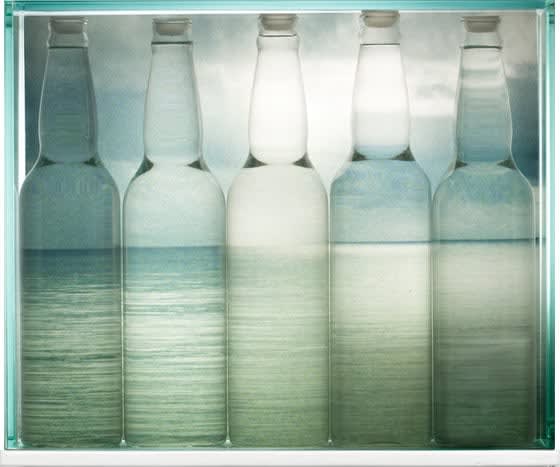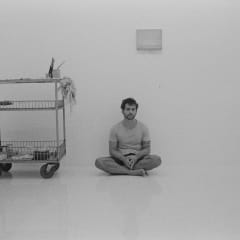Noite Azul Elétrico Group show
The Night. The exhibition takes place from the 22nd of June to the 27th of July. Precisely during the southern hemisphere’s winter solstice. The period when the nights are longer and the days consequently shorter. The nights are perfect to tell a story, to wander rudderlessly, like a ship, to a dream, to a party, to a date. The evening is a great backdrop, or large canvas, where the works of many artists can compose a vast landscape. Here the landscape begins with the white blue green and gray of the wall chosen by the artist Lucas Arruda.
The Blue. Blue is the crossroads between poetry and visual arts. Blue was for centuries the gold of the colors. The blue pigment was discovered in Afghanistan only 6,000 years ago. Before that it was not possible to paint this color. The Egyptians always used blue with gold. Throughout the history of art, blue was iconic, with obvious purity reasons in the blue robe of Our Lady. In contracts between patrons that commissioned works and artists who they commissioned, it always clearly specified how much and what kind of blue was to be used, as the pigment was rare and, therefore, the most expensive. Most civilizations had no word to distinguish between blue and green. In Japan, until the early twentieth century, there was only the word AO for both colors and even today, they often call the green traffic light blue. An indeterminate color. A kind of border – as the whole landscape.
The Electric. Electricity is magic. Source of electric light that illuminates, as in Picasso’s Guernica. In Eletric Blue Night, Jac Leirner illuminates the landscape with Little Light and activates the electric noun of the space. Perhaps, the most metaphorical work by the artist, it allows a strange frontier between poetry and minimalism. Night becomes more night and it becomes longer by the paradox of light. Electricity also projects the cartography, based on the magnetic field of the compass. Indicated here by Olafur Eliasson’s piece, Compass.
An exhibition without concepts or themes, Electric Blue Night is a landscape. An image that attempts to activate the poetic essence of works of art. On the electric video canvas, Karen Harley, Cao Guimarães and Leticia Simões, in different ways, bring poetry to the fore, the either through Leonilson – perhaps artist who is closest to poetry in Brazil in the late twentieth century – in Com o Oceano Inteiro para Nadar (With the whole ocean to swim in), or in Concerto para Clorofila (Concert for Chlorophyll), the poem landscape by Cao Guimarães, or the lyrical intimacy of the video Cesariny by the poet Leticia Simões. Movies to watch relaxing on a stool by Rivane Neuenschwander, an invitation to chat.
In Patricia Leite’s canvas, the blue night is made present, and in the words of f.marquespenteado, the poem arises, as well as in the blue messages by Fábia Schnoor. The drunken night landscape comes back in Horizonte Inebriante Pinga by Marcia Xavier, and finally José Bento’s plane / volume, conceptual framework for a landscape. Everything observed by Willys de Castro, an artist who has always been seen as a sculptor but should perhaps be reclassified as a painter. The most intense and concentrated of Brazilian painters.
Eletric Blue Night as I wrote it, is not a concept or a theme, just an image.
– Ricardo Sardenberg
The Blue
The everlasting Azure’s tranquil irony
Depresses, like the flowers indolently fair,
The powerless poet who damns his superiority
Across a sterile wilderness of aching Despair.
In flight, with eyes shut fast, I feel it scrutinize
With all the vehemence of some destructive remorse,
My empty soul. Where can I flee? What haggard night
Fling over, tatters, fling on his distressing scorn?
Oh fogs, arise! Pour your momentous ashes down
In long-drawn rags of dust across the skies unreeling
To darkly drench the livid swarm of autumn days,
And fabricate of them a great and silent ceiling!
And you, emerge from Lethean pools and gather in
While rising through them, freight of mud and pallid reeds,
Sweet Boredom, to block up with a never weary hand
The great blue holes the birds maliciously have made …
Still more! Unceasing let the dismal chimney-flues
Exude their smoke, and let the soot’s nomadic prison
Extinguish in the horror of its blackened queues
The sun now fading yellow away on the horizon!
– The Sky is dead. – To you I run, Oh matter! Bestow
Forgetfulness of Sin and of the cruel Ideal
Upon this martyr who comes to share the stable straw
On which the happy human herd lies down to sleep.
For there I long, because at last my mind, drained
As is a rouge-pot lying on a closet-shelf,
No longer has the art of decking tearful plaints,
To yawn lugubrious toward a humble death …
But vainly! The Azure triumphs and I hear it singIn bells.
Dear Soul, it turns into a voice the more
To fright us by its winged victory, and springs
Blue Angelus, out of the living metal core.
It travels ancient through the fog, and penetrates
Like an unerring blade your native agony;
Where flee in my revolt so useless and depraved?
For I am haunted! The Sky! The Sky! The Sky! The Sky!
– Stéphane Mallarmé












